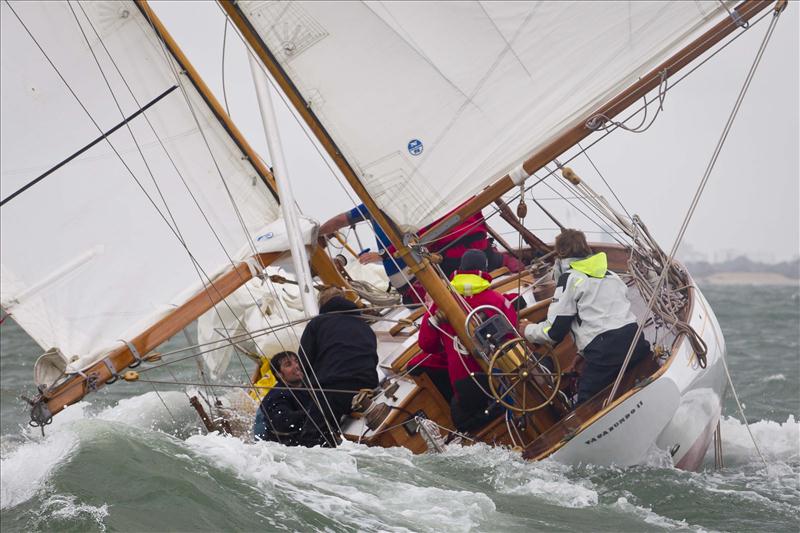
Panerai British Classic Week - day 6
by Deniz Karatepe 14 Jul 2012 08:37 BST
7-14 July 2012

Panerai British Classic Regatta day 6 © Guido Cantini / Sea & See
The penultimate day of the 2012 Panerai British Classic Regatta brought the formal racing to a conclusion with an inshore race, sponsored by Sandeman Yacht Company, in blustery winds of up to 30 knots from the southwest. Whilst the sky was still overcast, the rain held off allowing the boats to enjoy a fabulous final blast back and forth across the Solent that put huge grins on everyone’s faces.
Race results throughout the week were calculated for the six individual classes and in addition the scores of all the true classics (excluding the modern classics - recently constructed yachts built to a classic design) are combined to give an Overall Event Ranking with the winner receiving the prestigious Panerai British Classic Week Racing Trophy and a fabulous Panerai watch.
Scoring an incomparable five straight firsts, the 2012 winner of the Racing Trophy was David Sheriff’s 1897 Cork Harbour One Design Jap. At 21’4” on deck and 37’ feet overall she is amongst the smallest, not to mention oldest, boats racing this week. One of only ten Cork Harbour One Designs ever launched, she was constructed by Carrigaloe Gridiron Works, Cork to a design by William Fife III. Her crew combined youth and experience, including British Paralympic Gold Medallist Andy Cassell, top International Dragon sailor Martin Payne, up and coming young British match racers Mark Yeabsley and Toby Mumford and, bringing some gravitas to the team, Rear Admiral Richard Philips and Captain Alex Burton, Commanding Officer of the Royal Navy’s flagship HMS Bulwark. David gave all the credit for their success to his crew explaining that it had been a true team effort with he, Martin and Andy sharing helming duties and everyone contributing equally. Asked how he made his crew selection his response exemplified the spirit of this regatta as he explained that he simply chose “Good mates and people I’d like to know better.”
Second place in the Overall Event Ranking went to Andrew King’s Gluckauf, a 1929 International 30 Square Metre, built by Abeking and Rasmussen and known affectionately at the flying toothpick thanks to her long narrow shape. In third was David Murrin’s Cetewayo, a past winner of the Racing Trophy, whose racing pedigree includes many decades of victories.
Class 1, for the Modern Classics, came down to a two way dog fight between Hugh Morrison’s Pedrick designed Savannah and Stephen Jones’ self designed Meteor. Going into the day both boats had two first and two second places so everything rested on the final race. Despite Meteor’s best efforts she simply could not make her time on Savannah, who flew round the course to win by almost sixteen minutes and take the class overall by a single point. Meteor finished the race second to secure second in class with Stephen O’Flaherty’s Soufriere finishing third in the race and in class.
Cetewayo won the final race in Class 2 to claim the class overall by three points from Jamie Mattheson’s Opposition, built as Morning Cloud for Ted Heath in 1971, who had finished the race in third. Although second in race five, Brian Smullen’s McGruer ketch Cuilaun had to settle for third place in class.
In Class 3 the final race went to L’Esprit du Morbihan, Vincent de Vries’ 1969 Tina One Tonner. Yvon Nicolas’ 1963 Illingworth bermudan cutter Mirella came second and Glucklauf was third. In the overall class standings Glucklauf took the laurels with L’esprit du Morbihan second and Mirella third.
Jap’s five-win domination of Class 4 meant that the class’s big battle was for second place. Going into the day Roddy Steel & Eric Newman’s little Spidsgatter 19.5m Stren had looked good, but rough conditions forced them to retire from racing. Robert Veale’s Cheverton sloop Danegeld carried on to second in the race and snatched second in class leaving Stren third overall.
Knowing that their World Championship starts in just a couple of days, six of the 8 Metres elected not to race in today’s strong winds and Luna retired. Of the three that finished Richard Self and Mark DeCelles’ 1937 Alfred Milne designed Raven was first across the line followed by Hanns-Georg Klein’s Anne Sophie, a 1938 Bjarne Ass, and Falcon, designed by William Fife III in 1930 and owned by Jan Willem M Ypma. In the class standings it was Raven who claimed the overall prize with Anne Sophie second and Harri Roschier’s brand new Luna third.
The 6 Metres chose not to race in today’s strong winds and so the overall results for the class remained Tom Richardson’s Georgia first, Robin E Richardson’s St Kitts second and Peter Andreae’s Erica third.
At the prize giving dinner Panerai presented each of the class winners with a Panerai Instrument and in addition a number of special prizes were awarded. The Lallow Cup, for the best-presented new entrant, went to Robert Fabre’s Vagabundo II, a 1945 German Frers Snr classic bermudan ketch. The International Metre Trophy, for the highest placed Metre boat, went to Raven. Jap won the Brian Keeland Memorial Trophy, for the highest place gaffer. There were also some humourous awards including the Crunchie Awards presented to those who ran aground during the week which went to Eilean, Zarik, Sceptre, Atlantis, Marcita, Cetewayo and Sea Scamp. And finally the Cetewayo Cup for the Je Ne Sais Quoi competition, which is voted for by the competitors and goes to the boat with that “indefinable certain something”, was won by Andrew Pearson’s 1937 Johanas Anker designed Classic 10 Metre flush deck cutter Bojar.
The regatta concludes tomorrow with a Parade of Sail commencing at 11.00. The yachts will assemble off Gurnard before parading past Cowes Green and the Royal Yacht Squadron in a delightful traditional finale to the regatta.